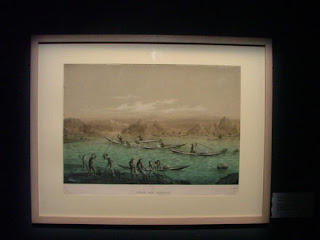A few years ago I was fortunate enough to visit an exhibition on historic canoes and kayaks in the southern Brittany town of Douarenenez. This delightful Breton town was the centre of the French sardine industry in the 19th Century, and at one time it was the home port to over 1,000 sardine boats. Although fishing still takes place on boats based in the port, the town itself is possibly now better known because of its maritime museum, “Le Port-Musee”.
The exhibition was called “Canoes and Kayaks la decouverte d’un nouveau monde”. There were over 150 exhibits, ranging from an early 19th Century painting to a modern sea kayak. It was essentially a history of paddling in France from the late 19th Century pioneers up to the present day including recreational and competitive developments.
The museum would have been well worth a visit even if there were no canoes and kayaks. as there is a wide range of traditional craft from a wide variety of European countries plus the added interest of a number of larger craft which are moored on the river. These include “Northdown” which is a traditional Thames barge and the “Saint Denys”, a tug built on the Clyde, which spent most of her working life based in Falmouth.
What was there of interest though, specifically for the paddler, in the Canoe and Kayak exhibition? One of the most modern items was one of the Catchiky’s which was paddled around Brittany in 1980 by Loik Bourdon and Franco Ferrero amongst others. Franco, from Pesda Press, was clearly making an appearance as an honorary Frenchman! This kayak certainly showed its age and the use it had been put to over 25 years. It is a model of kayak which is still in production and there was a new example of the type, from the manufacturer Plasmor.
There were a number of short films shown at various times and for me the most interesting was probably Christian Gabard’s film of the 1959 white water racing world championships. An interesting item shown in the film was an inflatable spray deck. Does anyone know whether they caught on? In the days before we became obsessed with risk assessments, it was interesting to see that some of the competitors didn’t wear helmets and others chose not to use buoyancy aids.
There were also a number of paintings and photographs which depict the historical origins of both canoeing and kayaking. Possibly the largest oil painting was by C. Giraud. Painted in 1857, it shows the Prince Napoleon taking part in a seal hunt off the west coast of Greenland. The use of kayaks for hunting is a theme which occured in a number of other exhibits. There was also a selection of framed posters from the last one hundred years. One in particular raised a slight smile although I am certain that the Hutchinson mentioned on the poster is not the same one who is practically a household name in sea kayaking.
It is always inspiring to see the standard of journeys which were undertaken in the past. For example, Gustaf Nordin, a Swedish canoeist who paddled from Stockholm to Paris in 1905 and Captain Lancrenon who published a book, “Trois Milles lieues a la pagaie,de la Seine a la Volga” in 1898, were both commemorated either through photographs or items of equipment. Lancrenan’s beautiful kayak, the Vagabonde III, was built in 1891 and broke down into two sections for easier transportation. It was exhibited alongside the Bic sit-on-top. 115 years of progress!
The more recent trends were not ignored. There was the inevitable Sit-on-top, plus white water play boats, racing kayaks, a slalom canoe from the Atlanta Olympics and winged paddles. I must admit though that I have never really looked upon a sit-on-top kayak as a museum piece.
There were a number of older exhibits, including a 19th Century Greenland kayak which is normally housed in a museum in Nantes, as well as a most beautiful birch bark canoe. The Greenland kayak was collected when the ship “La Recherche”, visited the area in 1835-6. It appears to have come from the Frederikshaab region, prior to being presented to the Nantes museum. In fact there were a number of canoes and kayak, which were like works of art as opposed to practical watercraft.
There were a number of older exhibits, including a 19th Century Greenland kayak which is normally housed in a museum in Nantes, as well as a most beautiful birch bark canoe. The Greenland kayak was collected when the ship “La Recherche”, visited the area in 1835-6. It appears to have come from the Frederikshaab region, prior to being presented to the Nantes museum. In fact there were a number of canoes and kayak, which were like works of art as opposed to practical watercraft.
It was a fascinating exhibition and I wonder when such a collection of historic canoeing and kayaking artifacts will be on show again?
Loik Bourdon's kayak in which he circumnavigated Brittany
The inevitable sit on top, although designs have become far more advanced since the time of the exhibition.
A couple of superb canoes. Absolute things of beauty.
"Emeraude" a mid 19th century kayak.
Photograph of the Swedish paddler, Gustaf Nordin, who traveled from Stockholm to Paris by kayak in the early 20th Century.
Surely not the famous sea kayaker Derek Hutchinson!
One of several kayaks from the 20th Century which were in the exhibition.
Inuit kayak from the 1830's. Usually shown in the Nantes Museum
A selection of paddles - new and old
Drawing of 19 Century paddling
One of many posters depicting the development of the sport














No comments:
Post a Comment